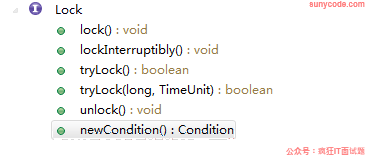09、Java JUC源码分析 - locks-ReentrantLock
ReentrantLock可重入锁,使用比synchronized方便灵活,可作为替代使用:
1、 支持公平/不公平锁;
2、 支持响应超时,响应中断;
3、 支持condition;
ReentrantLock实现了Lock接口,内部使用static类继承AQS实现独占式的api来实现这些功能,使用AQS的state来表示锁可重入次数:

之前学习AQS的时候说过请求和release的大的流程:
acquire:
if(!tryacquire())
加入AQS的等待队列
release:
if(tryrelease)
unpark等待队列的节点
先看下内部类的实现:
<span style="font-size:18px;">abstract static class Sync extends AbstractQueuedSynchronizer {
private static final long serialVersionUID = -5179523762034025860L;
/**
* Performs {@link Lock#lock}. The main reason for subclassing
* is to allow fast path for nonfair version.
*/
abstract void lock();
/**
非公平锁的acquire
*/
final boolean nonfairTryAcquire(int acquires) {
final Thread current = Thread.currentThread();
int c = getState();
//判断state是否被占用
if (c == 0) {
//没有被占用,直接cas占用,成功的话就设置当前线程为占用线程
if (compareAndSetState(0, acquires)) {
setExclusiveOwnerThread(current);
return true;
}
}
//如果state不为0,因为是可重入锁,需要判断是不是自己占用的,如果是累加state值
else if (current == getExclusiveOwnerThread()) {
int nextc = c + acquires;
if (nextc < 0) // overflow
throw new Error("Maximum lock count exceeded");
setState(nextc);
return true;
}
//acquire失败,AQS等待队列排队
return false;
}
//release的时候也需要判断是不是当前线程。因为可重入,所以可以lock多次,release的时候就要release多次
protected final boolean tryRelease(int releases) {
int c = getState() - releases;
if (Thread.currentThread() != getExclusiveOwnerThread())
throw new IllegalMonitorStateException();
boolean free = false;
if (c == 0) {
free = true;
setExclusiveOwnerThread(null);
}
setState(c);
return free;
}
/**AbstractOwnableSynchronizer.exclusiveOwnerThread 判断是否为当前占用lock的线程*/
protected final boolean isHeldExclusively() {
// While we must in general read state before owner,
// we don't need to do so to check if current thread is owner
return getExclusiveOwnerThread() == Thread.currentThread();
}
/**lock.newCondition每次直接new一个AQS的conditionObject维护一个条件队列*/
final ConditionObject newCondition() {
return new ConditionObject();
}
// Methods relayed from outer class
final Thread getOwner() {
return getState() == 0 ? null : getExclusiveOwnerThread();
}
final int getHoldCount() {
return isHeldExclusively() ? getState() : 0;
}
final boolean isLocked() {
return getState() != 0;
}
/**
* Reconstitutes this lock instance from a stream.
* @param s the stream
*/
private void readObject(java.io.ObjectInputStream s)
throws java.io.IOException, ClassNotFoundException {
s.defaultReadObject();
setState(0); // reset to unlocked state
}
}</span>
内部类实现了AQS独占api的tryRelease,看下公平和非公平锁的tryAcquire实现:
static final class NonfairSync extends Sync {
private static final long serialVersionUID = 7316153563782823691L;
/**非公平锁进来就cas,成功就设置独占线程,不成功再去Acquire排队,这就是公平不公平的区分*/
final void lock() {
if (compareAndSetState(0, 1))
setExclusiveOwnerThread(Thread.currentThread());
else
acquire(1);
}
/**直接使用父类中notFairAcquire*/
protected final boolean tryAcquire(int acquires) {
return nonfairTryAcquire(acquires);
}
}
static final class FairSync extends Sync {
private static final long serialVersionUID = -3000897897090466540L;
final void lock() {
acquire(1);
}
/**公平锁的tryAcquire*/
protected final boolean tryAcquire(int acquires) {
final Thread current = Thread.currentThread();
int c = getState();
if (c == 0) {
//锁还在并且AQS没有其他等待节点,cas设置,然后再设置独占线程
if (!hasQueuedPredecessors() &&
compareAndSetState(0, acquires)) {
setExclusiveOwnerThread(current);
return true;
}
}
else if (current == getExclusiveOwnerThread()) {
//因为是可重入锁,state不为0看是不是自己占用了,如果是更新state值
int nextc = c + acquires;
if (nextc < 0)
throw new Error("Maximum lock count exceeded");
setState(nextc);
return true;
}
return false;
}
}
//判断队列没有其他等待节点
public final boolean hasQueuedPredecessors() {
// The correctness of this depends on head being initialized
// before tail and on head.next being accurate if the current
// thread is first in queue.
Node t = tail; // Read fields in reverse initialization order
Node h = head;
Node s;
return h != t &&
((s = h.next) == null || s.thread != Thread.currentThread());
}
看下ReentrantLock对lock接口的实现和构造方法:
ublic ReentrantLock() {
sync = new NonfairSync();
}
public ReentrantLock(boolean fair) {
sync = fair ? new FairSync() : new NonfairSync();
}
public void lock() {
sync.lock();
}
public void lockInterruptibly() throws InterruptedException {
sync.acquireInterruptibly(1);
}
public boolean tryLock() {
return sync.nonfairTryAcquire(1);
}
public boolean tryLock(long timeout, TimeUnit unit)
throws InterruptedException {
return sync.tryAcquireNanos(1, unit.toNanos(timeout));
}
public void unlock() {
sync.release(1);
}
public Condition newCondition() {
return sync.newCondition();
}
默认是非公平锁,也可以传入参数明确要求采用公平还是非公平锁。对接口实现基本上都是调用AQS的东西。
基本来看出来ReetrantLock的公平和非公平的区分就是在Acquire的时候,非公平会先直接尝试cas修改,不成功再去排队,就是插队,而公平锁就是老老实实请求排队操作。
ReetrantLock还有其他一些监控方法,如isLocked等,没什么东西。